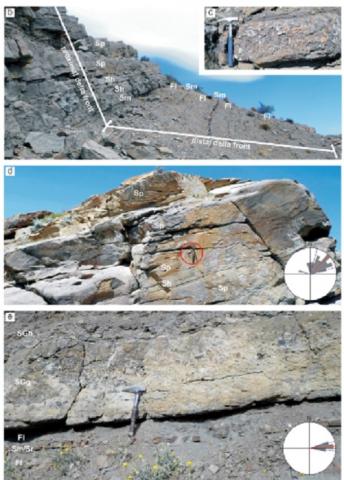María Paula Iglesia Llanos, Diego A. Kietzmann, Melisa Kohan Martínez, Daniel Minisini
2 019
Journal of South American Earth Sciences, Volume 94, October 2019, 102235
A systematic paleomagnetic study was carried out in the Lajas Formation (Middle Jurassic), cropping out at the Covunco creek in the central part of the Neuquén basin. The Lajas Formation at the Portada Covunco section consists of a succession of conglomerates, sandstones and mudstones that reaches c. 290 m-thick. On the basis of lithological and textural features, sedimentary structures, strata geometries, and fossil content, 14 facies were defined that were grouped in two facies associations within a fluvial-dominated delta system. The age of the Lajas Formation is rather controversial, and has been assigned from sequence stratigraphy and palynological data. Thus from south to north, interpreted ages span the Upper Aalenian–Middle Bathonian through the Callovian. Therefore, magnetostratigraphy was used to better precise the age of the Formation at Portada Covunco. Paleomagnetic data obtained from 29 sampling sites present reliable behaviors. Rock magnetic studies (thermomagnetic curves, K vs H curves, IRM acquisition curves) suggest that the remanence is carried by Ti-poor magnetite. Anisotropy of magnetic susceptibility data show clustering of the Kmax axes produced by the action of paleocurrents. The characteristic remanent magnetization passed a tilt test and a reversal test that prove its primary origin. The resultant magnetostratigraphy is characterized by a reverse-dominant with minor normal polarity intervals. When compared with the Bajocian-Bathonian reference geomagnetic polarity time scale (GTS2016), the best fit is achieved in the Lower through Middle Bathonian (Chrons M41 to M39). A paleomagnetic pole was calculated for Portada Covunco located at 167.1°E, 59.4°S, N = 28, A95 = 3.6°, K = 57.2. When compared with the other available paleopole of the same age −170 Ma-derived from dykes exposed at Mamil Choique, Patagonia, Portada Covunco falls in the same paleomeridian although at a lower latitude. Thus, it is interpreted that the studied section was not subjected to rotations around vertical axis (R = 4° ± 10°), but was compacted, which produced inclination shallowing of the magnetic vector (F = 18° ± 11°). The calculated inclination shallowing and amount of compaction in the section are well within the expected values in medium to fine-grained sandstones. Using the paleomagnetic pole from Mamil Choique as reference, the locality of Portada Covunco would have been located at c. 33°S during the Bathonian, in agreement with paleoclimatic interpretations derived from palynological data.

